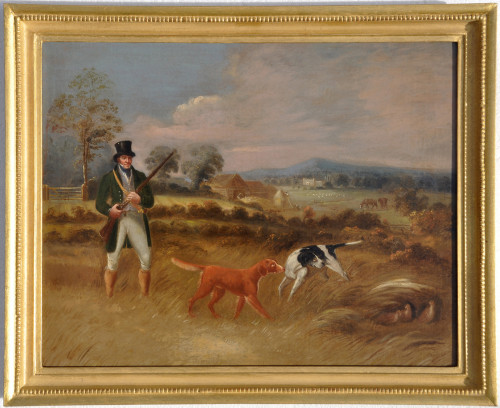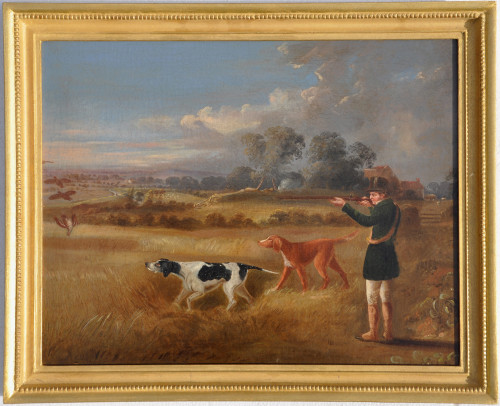Mr W Hepworth's "Little Driver" with Clift up
Mr W Hepworth's "Little Driver" with Clift up
JOHN FREDERICK HERRING SNR.
1795-1865
English School
Mr W Hepworth’s “Little Driver” with Clift up
Oil on canvas, signed, inscribed and dated 1823
56 x 76.2 cms
22 x 30 inches
Overall framed size 65.3 x 86 cms
25¾ x 337/8 ins
Provenance: Private Collection purchased from Ackermann early 1970s
Christie’s 1931 to Fores £115.
Literature: J F Herring and Sons – Oliver Beckett pp. 92 & 97, illustrated p98
John Frederick Herring Snr is regarded as one of the finest and most renowned sporting artists of the nineteenth century and as Grant says, "many of his works have become classics of their kind…"
He was born in Newgate Street, Blackfriars, London, one of nine children, and resided there until he was eighteen years old. His father, Benjamin, was a fringe maker and upholsterer originally of Dutch descent but had been born in British controlled America and subsequently came to England. John Frederick was always interested in drawing and sketching but was probably self-taught, although possibly the driver of the London-Woking coach, a family friend, aided him with drawing early on. His father though had always wanted him to continue the family business but his son apparently detested the work.
By September 1814, he had moved to Doncaster but the reason for this is unclear and various theories have been put forward. One was that there was an old branch of the family living there, another that he had eloped with Ann Harris (they were married by
1815), or it was purely the romantic thrill of travel. All his life he had seen and become fascinated with the Doncaster coach which passed his house daily and this may have thrilled his sense of adventure. Indeed, it is believed that he had learnt the skill of driving a coach team while still in his teens.
He had been in Doncaster only a short while when, passing a coach depot, he espied a coach painter unable to execute the depiction of a horse on a crest that he was doing for the side of a coach. The young Herring asked if he could help the painter and so impressed were the managers of the depot that they employed him to do the crests on a new coach, the Royal Forrester. He then heard that the driver of the Wakefield to Lincoln coach was retiring and so applied for the job, passing the test and earning the position as the driver of the Nelson which he did for the next two years. He was then transferred to the Doncaster-Halifax coach, which brought him into contact with Charles Spencer-Stanhope who was so taken by Herring's painting ability that he gave him his first commission. As early as 1815, the Doncaster Gazette engaged him to draw annually the winner of the St Leger and these were then turned into engravings which were published by Messrs Sheardown and Co, later taken over by S & J Fuller of London in 1826. This drawn recording of the St Leger winner was produced by Herring for thirty-three years in a row and later for the Epsom Derby, twenty-one times, also published by Fuller. Other engravings by him were published in "The Annals of Sporting" and this publication was fulsome in its praise of Herring.
His reputation spread rapidly through word of mouth and the publication of these prints and several people exhorted him to give up the coach driving career and take up painting full time. Herring, whether because he was keen to hold onto steady employment and source of income as his family grew - coach driving was a highly coveted career at that time - continued to drive, even taking up the position of the London coach which was a twenty-seven hour journey. In all, he drove for seven years until finally, he took up a guarantee of a year's commission to paint for a Mr Frank Hawkesworth. From this more work for local gentry ensued who were keen to have their racehorses and hunters immortalised on canvas.
Indeed, he had so much commission work that his output greatly exceeded his exhibited paintings and he only exhibited eleven works at the Royal Academy although the first of these was in 1818, a portrait of a dog. He also exhibited forty-four times at the British Institute and eighty-two at the Royal Society of British Artists in Suffolk Street, an institution of which he was later a vice-president.
By 1833, Herring and his family had settled in 31 Park St, Camberwell but in between London and Doncaster, he spent three years in the Newmarket area. The stay in London lasted initially seven years until apparently he experienced financial difficulties towards the end of this time as commission work had dried up. W T Copeland, the owner of the Spode China Company, came to his rescue, sorted matters out with his creditors and took the Herrings to a house on his estate in Leyton, Essex. Copeland commissioned a steady stream of paintings from Herring and some of these were utilised as transfers for decorating Copeland Spode bone china.
The 1840's saw Herring's commissions augmented by some major patrons such as the Duc d'Orleans who invited him to Paris to paint a number of works and some of these were engraved and published in Britain as well as France. Although he had been occasionally commissioned by both George IV and William IV, he was appointed painter to the Duchess of Kent (Queen Victoria's mother) in 1845 and in 1856, Queen Victoria herself granted him her patronage and continued to commission him for the rest of his life.
He had returned to Camberwell but in 1853, as a consequence of his rapidly improving fortune, decided to move to the country, taking up the lease on Meopham Park near Tonbridge in Kent. He had already diversified his subject matter beyond that of racehorses and hunters. Paintings appeared with all sorts of horse subject matter: horse fairs, narrative horse pictures, hunting scenes, coaching and carriage scenes; also in addition, rabbits, birds, goats, farmyard fowl and other animals, often incorporated into lively farmyard scenes. These last proved immensely popular and financially remunerative. He was assisted in the studio by his son Charles but his other two painter sons, Benjamin and John Frederick, worked on their own The latter worked in a style almost identical to his father and even signed in the same way. Herring Senior's brother, Benjamin was also a horse painter. Herring Snr also collaborated with the well known genre painters Thomas Faed and John Phillip as well as Sir Edwin Landseer.
John Frederick Herring enjoyed the life of a country squire and continued to paint up until his death despite ill-health and some physical incapacity. He had taken his love of horses to the extent that he purchased the Arab stallion Imaum which had originally been a gift to Queen Victoria and Herring often used the beautiful grey as a model. He died on 23rd Septmber 1865 and was buried in St John's, Tunbridge Wells.
Other publications for which he produced illustrations were The Illustrated London News, Bell's Life in London, The Illustrated Times and The Sporting Review. Some exhibited examples of his diverse output include: "Mail Coach descending a Hill", "Horses and Poultry", "Preparing to start for the Derby", "The Horse Fair on Southborough Common", "The French Blacksmith's Shop", "Pigs", "Rabini, before the Start of the Goodwood Gold Cup, 1833" and "Charles XII, a celebrated Race Horse"
His oeuvre was of a consistently high quality - it is believed he destroyed works he felt were inferior - and this is why he is still so highly regarded today. He had a keen and discerning eye for horseflesh and the landscapes, which provided the settings for his horse portraiture, were very well observed and beautifully executed and always of actual places.
Museums and institutions which hold examples of his work in their collections include: in London, Tate Britain, Victoria and Albert Museum, Guildhall; Glasgow Gallery, York Art Gallery, Leeds Art Gallery, Hutchinson House and the Paul Mellon Collection, Yale Center of British Art.
LITTLE DRIVER
Little Driver was a brown gelding by Ardrossan and was foaled in 1819. His first owner was Mr Cleaver followed by W Hepworth in 1823 and subsequently by Captain Berkeley, Captain Locke, Mr Williams and finally by Sir William Lumley. Little Driver won fifteen races - including the King's Plate at Donacaster in 1823 - between 1823 and 1827.
Bibliography: J F Herring and Sons - Oliver Beckett
Dictionary of British Equestrian Artists- Sally Mitchell
Dictionary of British Landscape Painters - M H Grant
Dictionary of Victorian Painters - Christopher Wood
Yorkshire Artists - Harry Turnbull
British Sporting Painting 1650-1850 - Hayward Gallery 1975
Dictionary of British Animal Painters - J C Wood
Dimensions:
1795 - 1865
Oil on canvas
England
signed, inscribed and dated 1823
Private Collection purchased from Ackermann early 1970s
Christie's 1931 to Fores £115.
J F Herring and Sons - Oliver Beckett pp. 92 & 97, illustrated p98
RELATED ITEMS


























